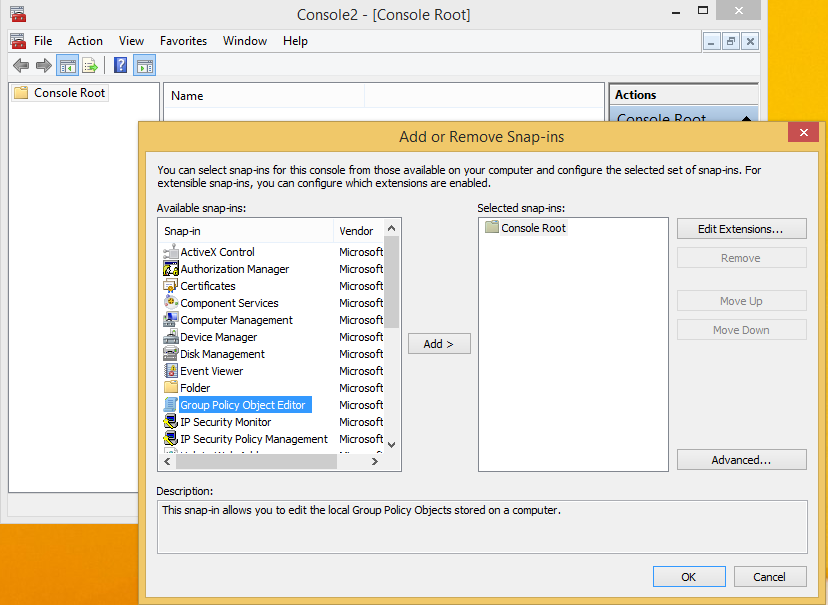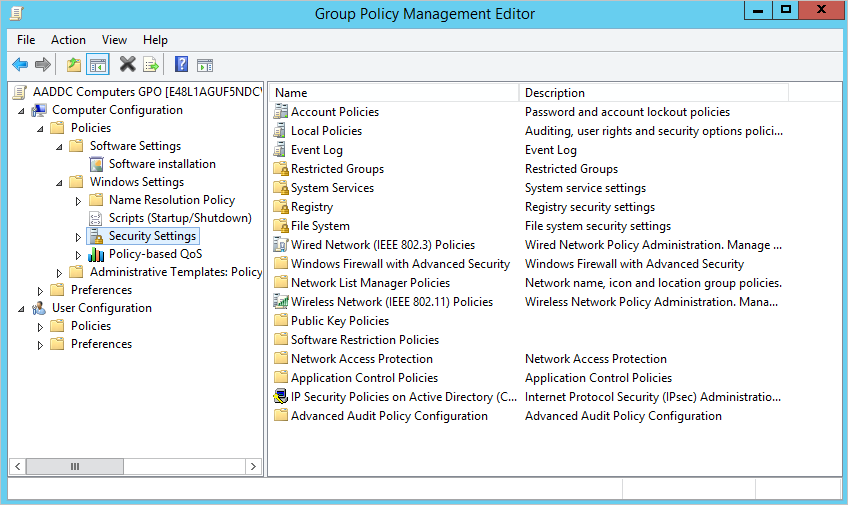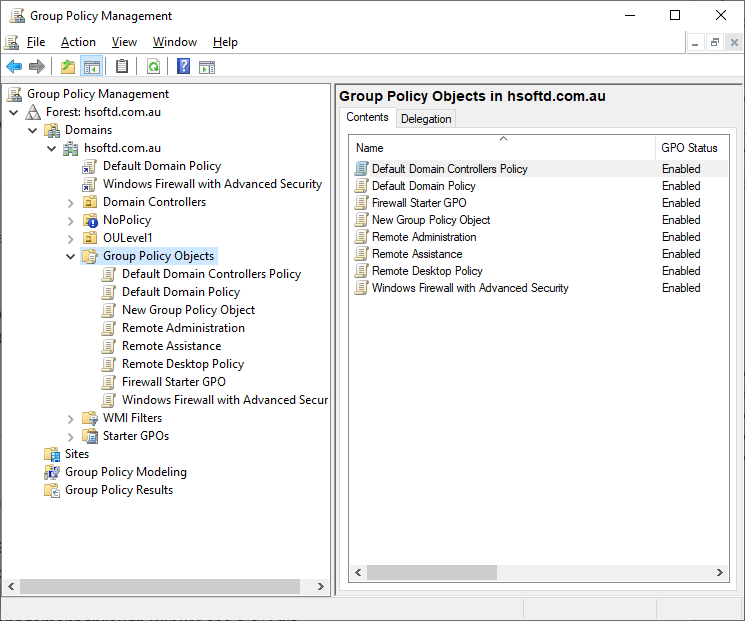How To Edit A Gpo In Active Directory
The following steps illustrate how to view the various settings configured under a GPO:
- Open the GPMC snap-in. To do that, go to Start Menu Administrative Tools Group Policy Management Console.
- Right-click on the Group Policy Objects container and select a GPO.
- In the right pane, select the Settings Tab and click Show all.
- If the policy settings are not defined for a GPO, both Computer configuration and User configuration sections will show No settings defined.
- To configure policy settings for the GPO, right-click anywhere on the right pane or on the GPO and select Edit.
- The Group Policy Object Editor will open. Browse through the Computer configuration and User configuration settings and define them as necessary.
Disable Forced System Restarts
Forced system restarts are common. For example, you may face a situation where you were working on your computer and Windows displays a message stating that your system needs to restart because of a security update.
In many cases, if you fail to notice the message or take some time to respond, the computer restarts automatically, and you lose important, unsaved work. To disable forced restart through GPO, perform the following steps:
Figure 4: No system auto-restart with logged on users
Installing Samba Admx Templates
In order to configure Samba Group Policies, you must first install the ADMX templates provided by Samba.
samba-tool gpo admxload -U Administrator
The samba-tool gpo admxload command copies the Samba ADMX templates to the < domain> /Policies/PolicyDefinitions directory on the SYSVOL share.
If you have more than one domain controller you should run the command with ‘-H’ in order to insure the ADMX templates are installed on the correct DC e.g.
samba-tool gpo admxload -H dc1.samdom.example.com -U Administrator
| After installing the Samba ADMX templates, you MUST install Microsoft’s ADMX templates also, otherwise you will be unable to administer Windows domain members. |
To install Microsoft’s ADMX templates:
msiextract /path/to/microsoft/download/Administrative\ Templates\ \\ for\ Windows\ 10\ October\ 2020\ Update.msi samba-tool gpo admxload -U Administrator --admx-dir=/path/to/extracted/msi/Program\ Files/Microsoft\ Group\ Policy/Windows\ 10\ October\ 2020\ Update\ \/PolicyDefinitions/
| The msiextract command can be found in the msitools package on most distributions, including Debian/Ubuntu, RHEL/CentOS, and Arch linux in the AUR. |
You May Like: How To Set Up My Own Email Domain
How To Add A User To The Administrator Group
Click on the Manage option. Click on the Local Users and Group tab on the left-hand side. Click on the Users tab. A list of users will be displayed. Right-click on the user you want to add as an admin. Go to properties -> Member Of tabs. Select the Add button. Go to Advanced. Click on the Find now option. Visit site
What Is The Group Policy Editor

Group Policy Editor is a utility that allows you to configure Group Policy settings for a Windows PC or a group of PCs. Aimed mostly at network administrators, Group Policy defines how you or a group of people can use your machines, restricting or allowing features as necessary.
Group Policy Editor is a Microsoft Management Console app with the filename gpedit.msc, and its usually located in the C:\Windows\System32 folder.
Its important to note that Group Policy Editor is not available in Windows 10 Home. It only ships with Windows 10 Pro or Windows 10 Enterprise. If youre not sure which edition of Windows you have, its easy to find out. Open Settings, navigate to System > About, and youll see it listed under Edition.
There are several ways to open Group Policy Editor in Windows 10, so well cover a handful of major ways to do it below. Each one will get you to the same place, so pick whichever suits you best.
RELATED:What Is “Group Policy” in Windows?
Don’t Miss: Does A Domain Name Expire
Group Policy Management Console
Group Policy settings are configured in Group Policy objects . You can link GPOs to domains, sites and organizational units . For even more control, GPOs can be applied according to the results of Windows Management Instrumentation filters, although WMI filters should be used sparingly because they can significantly increase policy processing time.
The Group Policy Management Console is a built-in Windows administration tool that enables administrators to manage Group Policy in an Active Directory forest and obtain data for troubleshooting Group Policy. You can find the Group Policy Management Console in the Tools menu of Microsoft Windows Server Manager. It is not a best practice to use domain controllers for everyday management tasks, so you should install the Remote Server Administration Tools for your version of Windows.
How To Create A Gpo In Active Directory
GPOs can be created and managed using the Group Policy Management Console . The configuration settings can be edited using the Group Policy Object Editor console. The following steps illustrate how to create a GPO:
- Open the GPMC snap-in. To do that, go to Start Menu Administrative Tools Group Policy Management Console.
- In the left pane, expand the Forest container and then the domain container.
- Select the domain for which the policy settings have to created and applied.
- Double-click on the domain to see a list of OUs and other containers in the domain.
- Right-click on the Group Policy Objects container and select New.
- Enter the name of the GPO and click OK.
You May Like: How Do I Buy A Web Domain Name
Editing Group Policy Settings Preferences And Properties
After you check out the GPO, you can edit the policy settings, preferences and properties of a GPO. When you check out a GPO, GPA opens the NetIQ Group Policy Management Editor, which you can use to add or modify any Group Policy setting. By editing these settings in the GP Repository, GPA only makes changes to the GPO in the GP Repository. Your edits do not change the Active Directory instance of the GPO until you export the GPO from the GP Repository to Active Directory.
To edit GPO settings:
Log on to a GPA Console computer with an account that has permissions to check in and check out GPOs and modify GPO settings. To add or modify preferences, log on to a GPA Console computer that supports preference management.
Start the GPA Console in the NetIQ Group Policy Administrator program group.
In the left pane, expand GP Repository to the category level and select the GPO you want to check out.
If the GPO is not already checked out, on the Action menu, click Check Out. Group Policy Administrator launches the NetIQ Group Policy Management Editor.
If the GPO is already checked out, on the Action menu, click Edit GPO.
In the left pane of the NetIQ Group Policy Management Editor, expand the GPO to the level of the Group Policy setting you want to modify or to the Group Policy Preference extension for the preference you want to add or edit.
Complete one of the following steps, based on what you want to configure or add:
Close the NetIQ Group Policy Management Editor.
Using The Local Group Policy Editor To Change Settings For All Users On The Local Computer
If you want to apply the settings for all users, there are many ways to launch the Local Group Policy Editor. Check out our article on how you can open the Local Group Policy Editor in Windows for more details. The quickest method is simply pressing the Windows key on the keyboard , then typing gpedit followed by Enter. This opens the Local Group Policy Editor immediately.
Open the Local Group Policy Editor from the Start Menu
Don’t Miss: What’s A Good Domain Authority Score
Updating Group Policy Settings On Windows Domain Computers
In this article we will show how to update Group Policy settings on Windows computers in an Active Directory domain: how to update Group Policies automatically, how to use the GPUpdate command, how to update them remotely using the Group Policy Management Console or the Invoke-GPUpdate PowerShell cmdlet.
Report On Active Directory Access Control Permissions For Users And Groups
- Permissions for folder reports: Use this NTFS reporting tool as a folder permissions auditing tool to see which users and groups have access to folders in a specified path. The associated access control entries will indicate the level of access a user or group has for a folder, and specify the inheritable permissions, if any.
How to list the users and groups who have access to a specific folder using ADManager Plus.
- Log in to ADManager Plus and access the Permissions for Folders report.
- Specify the path of the folder and the level of access.
- Generate the report.
You May Like: Why Are Gg Domains So Expensive
Enable Certificate Auto Enrollment On The Client
To setup Certificate Auto Enrollment:
| Samba’s gpupdate will work with SSSD, but will require the oddjob-gpupdate package in order to apply policies automatically. |
Resultant Set of PolicyComputer Policy GPO: Default Domain Policy======================================================================================================================CSE: gp_cert_auto_enroll_ext-----------------------------------------------------------Policy Type: Auto Enrollment Policy----------------------------------------------------------- = =----BEGIN CERTIFICATE----< REDACTED> ----END CERTIFICATE---- = < REDACTED DNS NAME> =----------------------------------------------------------------------------------------------------------------------======================================================================================================================
Issuing the `getcert list` command will display the installed certificates:
Manage Group Policy Objects

Unlike native Group Policy management tools, ADManager Plus lets you create Group Policy Objects in Active Directory and bulk apply GPOs to users, computers in OUs, sites, or even an entire domain, either while creating a GPO or later on. This Group Policy management feature also provides a quick search capability to locate and edit Group Policy Objects’ Administrative Template settings. Enable GPOs’ user and computer configurations or disable them you can even delete multiple GPOs in one go.
You May Like: How To Buy A Site Domain
Prevent Unauthorized Access To Ntfs Partitions And Shares
Gain complete visibility into the NTFS and share permissions of all files and folders to prevent the misuse of files, including the corruption of file content due to unauthorized access. Generate access permissions reports for folders, files, and server shares. Drill down to the actual folder or file, and analyze the security settings and ACLs so you can take appropriate action and streamline user access control.
How To Backup And Restore Gpos In Active Directory
Backing up and restoring GPOs in Active Directory can be done using the GPMC. Here are the steps you need to follow:
- Go to Start, and navigate to Administrative tools. Then, navigate to Group Policy Management and click on it.
- In the GPMC window that opens, expand the Group Policy Objects folder that contains the GPO which you want to be backed up.
- Right-click the GPO, and then click Back Up.
- This will open the Backup Group Policy Object window. Specify the path to the folder where you want the backed-up version of the GPO to reside.
- Once done, click Back Up.
Once the GPO backup operation is done the window will intimate you of successful completion of the GPO backup, click OK. Youll now have backed up all the GPOs. You can verify if the GPOs have been backed up, by navigating to the folder you specified during the backup process. You should see a list of folders that would contain the GPO backup data. With this data, you can either restore a deleted GPO, or a modified GPO as necessary. To learn more about GPO backup, you can read this article.
People also read
Also Check: What Do You Do After You Buy A Domain Name
What Is Local Group Policy Editor
The Local Group Policy Editor is a Microsoft Management Console that built in every system to help administrators manage Group Policy settings within Group Policy Objects . The Local Policy Editor contains mainly 2 sections: Computer Configuration and User Configuration .
Open Windows 11 Group Policy Editor By Its Shortcut
Finally, you can launch the Win 11 Group Policy Editor by creating a desktop shortcut of it. Right-click on the desktop and select New > Shortcut. In the new window, type the location of the item as gpedit.msc and click Next and then Finish to complete. Then, you will see a new shortcut named gpedit appear on your desktop. Just double-click on it will open Windows 11 Group Policy Editor.
You May Like: What Is A Sub Domain
Modify Active Directory User Attributes In Bulk
Managing Active Directory user accounts is an arduous challenge that IT administrators face every day. Manually configuring and modifying user properties with native tools, such as PowerShell scripts, can be tiresome and error-prone. With PowerShell, administrators often find that simple, frequently occurring tasks, like resetting AD passwords and unlocking accounts, consume too much of their time.
ADManager Plus is web-based Active Directory user management software that facilitates bulk modification of user attributes in AD, Exchange, Google Workspace, Microsoft 365, and Skype for Business. Using ADManager Plus’ reactive user account management feature, it’s easy to automatically update attributes of user accounts based on the changes that are being made to those accounts. This AD user modification tool also allows administrators to securely and easily delegate specific AD bulk user operations to help desk technicians.
The Local Group Policy Editor Layout
Whether you use it on Windows 11 or any other version of Windows, the design of the interface looks identical. Starting from the top, you have a series of menus, then a toolbar that lets you, among other things, navigate through the policies. Feel free to click on the menu items and the toolbar buttons to familiarize yourself with the interface, you are not going to break anything :).
Hovering over the toolbar buttons displays a tooltip
The main elements of the interface are below the toolbar. In the default view, the Local Group Policy Editor has a navigation pane called Console Tree on the left, where you can select the policy category or node. In the center, the main section lists all the policies in the selected category, as well as a very useful description of any policy you select. The policy list contains the name of the policy, the state , and the comments added by you or other administrators. When selecting All Settings in the Console Tree, an additional column is displayed, showing the path of that particular setting in the tree.
Selecting a policy in the main section displays a description of the setting
Finally, by pressing the corresponding buttons in the toolbar, you can show or hide the Console Tree on the left and an Action pane on the right of the main window.
Use the buttons in the toolbar to show or hide the left and right panes
Also Check: How To Find Dns Host For A Domain
What Is Windows 11 Group Policy Editor
Group Policy is a feature of the Microsoft Windows NT family of operating systems including Window 11, Windows 10, Windows 8.1/8, Windows 7, as well as Windows Server 2003+. It controls the working environment of user accounts and computer accounts.
Group Policy offers centralized management and configuration of OSes, apps, and users settings in an Active Directory environment. A set of Group Policy configurations is known as Group Policy Object . A version of Group Policy called Local Group Policy allows GPO management without Active Directory on standalone computers.
Therefore, Windows 11 Group Policy Editor refers to the editor that can change Group Policy configurations and settings in Windows 11. Next, lets see how to open Windows 11 Group Policy in different ways.
Note: The Group Policy isnt provided on Home Editions of Windows 11/10/8.1/8/7/Vista/XP.
Assigning Registry Key Permissions Via Group Policy

Also, you can assign permissions to registry keys using Windows Group Policy. This feature may be useful when you grant a user permission to system-protected registry keys or want to prevent non-administrator users from changing certain registry keys.
You May Like: How To Get A Nyc Domain